Sandstone is one of the most common sedimentary rocks usually located within the sedimentary basins. Sandstones are formed when sand deposits are transported by the agents of denudation such as wind, water, and thawing ice and finally deposited in the basins where they are, accumulated, compressed, and hardened.
The sands are usually laid down and buried deep underground. The process of sandstone deposition usually takes place offshore from a river delta. Here, the sand fragments are compressed and hardened to form a sedimentary rock known as sandstone. Therefore sandstone refers to a group of fragmental rocks whose average grain size varies from 0.0625 to 2 millimeters. This rock is made up of many mineral types of rock fragments, mainly mono-mineral gypsum and calcite, with the most predominant type of mineral rock fragment being quartzite feldspar. These rock fragments usually determine the realm of the chemical composition of sandstone (Wen, F., Tian, Z., Liu, P. H., Xu, W., Liu, F., & Mitchell, R. N. (2021)
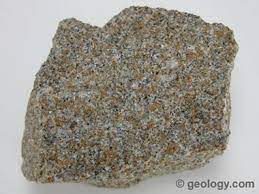
Moreover, sandstone can be classified as either a platform or a basin deposit. Platform sandstones refer to those which accumulate under conditions of tectonic stability as well as steady homogenous currents. On the other hand, basin sand deposits refer to those sandstone deposits deposited in rapidly subsiding areas that have experienced heavy and consistent sedimentation with a robust rhythmic current that prevails. These two significant groups of sandstone deposits are further subdivided into smaller petrographic types within various characteristics and from where depositional environments are inferred.

TYPES OF SANDSTONE DEPOSITIONAL ENVIRONMENTS
From a geological point of view, a deposition or sedimentary environment in the context of sandstone deposition is used to describe the physical, chemical, and biological processes that are associated with the deposition of sandstones and, therefore, the general composition of the resulting sandstone rock concerning its chemical, physical and biological composition. Often, depositional environments associated with sandstones are usually regarded as very substantial, and they range from terrestrial or continental to marine environments. The three main types of sandstone depositional environments to be discussed in this context are the continental or terrestrial, transitional or marginal marine, and marine environments (Puy-Alquiza, M. J., Miranda-Avilés, R., García-Barragán, J. C., Loza-Aguirre, I., Li, Y., & Zanor, G. A. (2017).
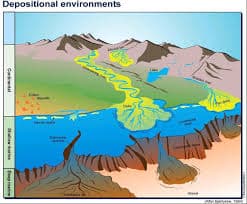
Continental sandstone environment
The continental sandstone depositional environment, also known as the terrestrial, refers to a non-marine environment mainly composed of dry land where non-marine evaporates sandstone deposits are a common type of rock fragments. This environment is mainly located in the basins. Therefore most of the sandstones deposited here are usually due to heavy and consistent sedimentation with a solid rhythmic current. Sandstone deposits in continental environments usually play a more significant role in determining the climatic and tectonic conditions and may contain economically significant mineral resources (Li, C., Hu, X., Wang, J., Vermeesch, P., & Garzanti, E. (2020). The four main types of the continental sandstone environments depositions include
- Alluvial is a fluvial deposit caused by moving water in a fan shape or an alluvial fan. This type of deposition contains impermeable and nonporous sediments which are well sorted.

- Fluvial is a type of deposit due to moving water such as streams. Apart from sandstone deposits, other common types of deposits in this deposition include graves and silt.
- Aeolian is a type of deposition that occurs mainly due to wind activities and is, therefore, more predominant in the deserts and the coastal regions. Deposits in this type of deposition are usually of a large scale and are cross-bedded.
- The lacustrine deposition is caused mainly due to moving water from lakes. Deposits in this type of deposition include sandstones, silt, and clay.
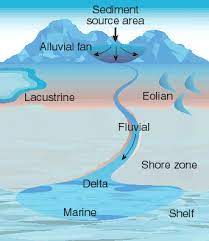
Transitional/marginal sandstone marine environment
Transitional or marginal marine Sandstone environments are the type of environments found along the edge of the continents. They are usually located at or near where the land meets the sea. Transitional sandstone environments include deltas beaches, lagoons, tidal flats, salt marshes, and barrier islands.
- Delta is a sandstone marine depositional environment located at the mouth of a river. Possible cross-beds and ripple marks characterize it. It is also characterized by sandstone sediments in the form of channel sands mixed with mud leading to the formation of cross-bed-like sedimentary structures.
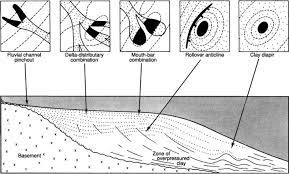
- The tidal environment is caused due to the rise and fall of the sea levels due to astronomical gravitational influence. Sandstone deposits in this environment result in the creation of tidal flats with fine-grained ripple marks and cross-beds.
- Beach is a sandstone marine depositional environment made up of loose particles of sand at the edge of the sea or a water body. It is formed as a result of waves and longshore currents.
- Lagoon- A lagoon is a shallow water body separated from a large water body by a narrow landform. The typical sediments in this area include sands and carbonates.
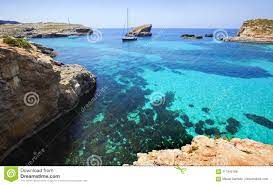
- Lake- This is a large water body that is made up of relatively still waters. Some of the depositional fragments in this environment include sands, clay, and silt.
Marine sandstone environment
Marine sandstone depositional environments are located within the water bodies such as lakes, seas, or oceans. The marine depositional environment comprises shallow-water marine environments, which are made up of the upper shoreface marine environment and lower Shore face marine depositional environments. The other types of marine environments are the deep-water marine and the reefs. The shallow-water marine environment results in sediments and sandstone rock products resulting from depositional environments located between the land and the sea. Due to the waves and tidal current actions, the deposition of sandstones in this environment results in the creation of shelves, slopes, and lagoons (Siddiqui, N. A., Rahman, A. H. A., Sum, C. W., Yusoff, W. I. W., & bin Ismail, M. S. (2017).

Additionally, the upper shoreface refers to the portion of the seafloor that is shallow enough to be agitated by the daily wave action. In contrast, the lower shoreface is a portion of the seafloor and sedimentary sandstone deposit environment below the daily wave action. Moreover, the deep-water sandstone marine environment is a flat and deep ocean floor caused by ocean currents with sandstones as the most common type of sediments. The Reef is another type of marine environment that is composed of a shoal of rock, corals, and other marine materials lying beneath the water’s surface and is usually caused by waves and tidal currents with sandstone as the primary type of sediments in this environment.
Quartz Sandstone Depositional Environment
Quartz sandstone is a type of sedimentary rock that is composed mainly of sand-sized quartz grains. It is formed by the accumulation of sand grains that have been transported and deposited by wind or water. The depositional environment of quartz sandstone can provide clues about the conditions in which it was formed.
The following are some common depositional environments for quartz sandstone:
- Beaches: Quartz sandstones can form on beaches where waves and currents deposit sand grains. These deposits are typically well-sorted and show evidence of wave or current ripples.
- Rivers: Quartz sandstones can also form in river channels where fast-moving water transports and deposits sand grains. These deposits can be well-sorted and may show evidence of cross-bedding.
- Dunes: Quartz sandstones can form in desert environments where sand dunes migrate and are preserved. These deposits are typically well-sorted and may show evidence of cross-bedding and other features associated with dune migration.
- Alluvial Fans: Quartz sandstones can also form in alluvial fans, which are cones of sediment that form at the base of mountain ranges. These deposits are typically poorly sorted and may show evidence of channelized flow and debris flows.
- Offshore: Quartz sandstones can form in offshore environments where sediment is transported and deposited by ocean currents. These deposits are typically well-sorted and may show evidence of current ripples.
CONCLUSION
Therefore the depositional environments associated with sandstones are usually very significant in terms of their economic significance. These environments are usually in a wide range from continental to deep marine, and they contain a lot of mines and reservoirs for precious minerals such as petroleum and limestone. For instance, sandstone is a well-known petroleum clastic reservoir rock with excellent porosity and permeability that provides a conducive environment for the exploitation of petroleum. However, it is worth noting that the sandstone reservoir quality is mainly affected by cementation, dissolution, and compaction processes. Therefore, for an exhaustive, correct, and effective analysis and gaining knowledge associated with depositional environment and digenetic burial history, it is essential to do feasibility studies on the depositional environments since they are environments of economic importance (Wei, J., Chen, S., Gu, Y., Zhang, H., Yin, S., & Yuan, H. (2021).
REFERENCES
Siddiqui, N. A., Rahman, A. H. A., Sum, C. W., Yusoff, W. I. W., & bin Ismail, M. S. (2017). Shallow-marine sandstone reservoirs, depositional environments, stratigraphic characteristics and facies model: A review. Journal of Applied Sciences, 17(17), 212-237.
Puy-Alquiza, M. J., Miranda-Avilés, R., García-Barragán, J. C., Loza-Aguirre, I., Li, Y., & Zanor, G. A. (2017). Facies analysis, stratigraphie architecture and depositional environments of the Guanajuato conglomerate in the Sierra de Guanajuato, Mexico. Boletín de la Sociedad Geológica Mexicana, 69(2), 385-408.
Shalaby, M. R., bin Haji Irwan, M. I. I., Osli, L. N., & Islam, M. A. (2020). Geochemical characteristics and depositional environments of the Narimba Formation source rock, Bass Basin, Australia. Journal of Petroleum Exploration and Production Technology, 10(8), 3207-3225.
Li, C., Hu, X., Wang, J., Vermeesch, P., & Garzanti, E. (2020). Sandstone provenance analysis in Longyan supports the existence of a Late Paleozoic continental arc in South China. Tectonophysics, 780, 228400.
Wei, J., Chen, S., Gu, Y., Zhang, H., Yin, S., & Yuan, H. (2021). Diagenesis and reservoir classification criteria for Jurassic continental sandstone oil reservoir in the western Ordos Basin, China. Geological Journal.
Wen, F., Tian, Z., Liu, P. H., Xu, W., Liu, F., & Mitchell, R. N. (2021). Sedimentary evidence for the early Paleoproterozoic tectono-magmatic lull: Detrital zircon provenance of the 2.47–2.17 Ga Langzishan Formation, Liaohe Group, Eastern Block of the North China Craton. Journal of Asian Earth Sciences, 221, 104939.
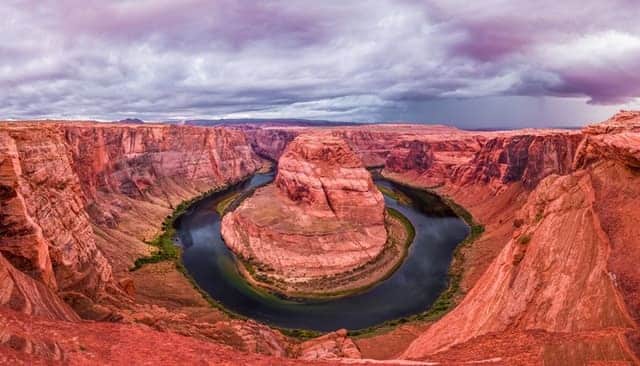


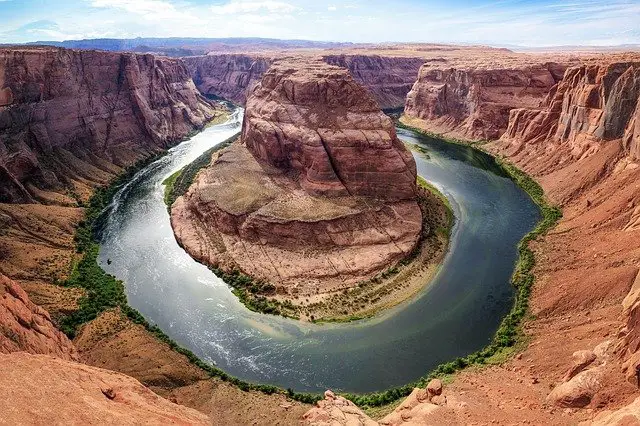
[…] structures are essential since they provide information about the depositional environments such as flow direction, climate, arid or semi-arid, and setting either fluvial, lacustrine, or […]
[…] us to understand how these fossils evolved over time. The fossil evidence can tell us about the environment in which the fossils […]
I’m not sure why but thiѕ site is loading incredibly slow for me.
Is anyone else having this problem or is it a
problem on my end? I’ll check back later on and see if the
pгoblem stіll exists.
I’m so sorry to hear that pails.
Actually yesterday my website was down for a few minutes. I contacted the hosting provider to check the problem and avoid it in the future.
Thanks for your comment.
Thank you for writing about this topic. It helped me a lot and I hope it can help others too.
Thanks for your help and for posting this. It’s been great.
Grеetіngs! Very һelρful advice in this particular article!
It iѕ the little changes that produce the biggest changes.
Тһanks a lot for shɑring!
Ι relish, resuⅼt in I discovered just what I was having a look
for. You have ended my four day lengthy hunt!
God Bless you man. Have a great day. Βye
Thank you for your articles. They’re very helpful to me. May I ask you a question?
I really enjoyed reading your post and it helped me a lot
Thank you for writing such an excellent article, it helped me out a lot and I love studying this topic.
Thanks Norris
Thanks Leila
Yes of course.
Excellent way of describing, and pleasant post to take information regarding my presentation topic,
which i am going to convey in university.
Thanks Tabitha.
I wish you a very successful presentation.
I believe that is one of the such a lot important info for me. And i’m satisfied studying your article. But should statement on some common things, The site taste is perfect, the articles is truly great : D. Excellent process, cheers
Thanks
[…] rocks are red, it’s generally because iron oxides are present. Red sandstone, like that seen in Zion National Park and the rest of Southern Utah, is made up of white or […]